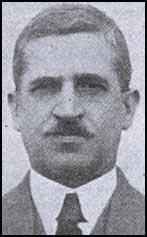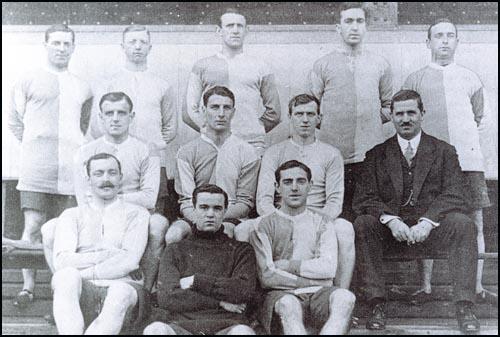 Robert
Middleton worked as a schoolteacher before becoming
secretary/manager at Darwen. He also worked for Rotherham United
and Blackpool before joining Blackburn Rovers in July 1903. He
replaced Joseph Walmsley who had been accused by the Football
Association of approaching Everton players about fixing a vital
game against Blackburn. Robert
Middleton worked as a schoolteacher before becoming
secretary/manager at Darwen. He also worked for Rotherham United
and Blackpool before joining Blackburn Rovers in July 1903. He
replaced Joseph Walmsley who had been accused by the Football
Association of approaching Everton players about fixing a vital
game against Blackburn.
Middleton purchased Bob Evans, a Welsh international goalkeeper,
from Wrexham for £150. In November, 1903, Middleton also
persuaded Fred Pentland, who had scored five goals in eight
games for Blackpool, to join the club. Pentland scored seven
goals in 18 league appearances, but his efforts could not stop
Blackburn from being involved in another relegation struggle.
The club eventually finished in 15th place in the league.
It was the same story the following season. Despite good
individual performances from Bob Crompton, Adam Bowman, Bob
Evans, Fred Blackburn, and Arnie Whittaker, Blackburn could only
finish in 13th place. Bowman was the top scorer with 13 goals.
In an article that appeared in the Blackburn Times a journalist
wrote: "Like its two predecessors, the season of 1904-05 has
been one of disgrace to the Rovers".
Lawrence Cotton, a local wealthy businessman, became chairman of
Blackburn Rovers in March 1905. The following month Robert
Middleton signed Welsh international striker, Billy Davies from
Wrexham. Ellis Crompton, another young player with a reputation
for scoring goals, also joined the club. At the same time, two
of Blackburn's best players, Lionel Watson and Fred Blackburn,
joined West Ham United. Blackburn, an English international,
left because he was upset with the decision not to grant him a
benefit. Fred Pentland who was unable to maintain his goal
scoring form, moved to Brentford in the Southern League.
Blackburn Rovers finished in 9th place in the 1905-06 season.
Adam Bowman was once again the club's top scorer with 15 goals.
His strike partner, Billy Davies, added 11 more. That year,
Middleton lost the services of Blackburn's talented centre-half,
Sam McClure, who died after an abscess in the ear spread inwards
towards the brain.
Robert Middleton made several significant signings that year,
including Jack Martin, Edwin Latheron, and Wattie Aitkenhead.
Kelly Houlker, who had played for Blackburn Rovers between 1896
and 1901, also rejoined the club. However, now aged 34, he was
passed his best and only managed 31 more games over the next two
years.
Lawrence Cotton helped to raise the money to improve the Elwood
Park ground. On 1st January, 1907, the recently constructed
Nuttell Street Stand was opened. It could accommodate 4,112
supporters seated in the upper tier, with room for a further
9,320 standing in front. A crowd of 35,000 watched Blackburn
draw 1-1 with Preston North End.
Blackburn Rovers finished in 12th place in the 1906-07 season.
They were knocked out of the FA Cup by Tottenham Hotspur but won
the Lancashire Cup when they beat Liverpool 3-0. Jack Martin
proved to be a great buy and ended up the club's leading scorer
with 17 goals.
1907-08 season was very disappointing. Blackburn Rovers was
knocked out of the FA Cup in the first round when they were
defeated by Second Division Leicester Fosse. They also had a
first round exit in the Lancashire Cup. Blackburn's league form
was little better and after a late rally they finished in 14th
place. Billy Davies, Edwin Latheron and Jack Martin, ended up as
joint top scorers with 9 goals each.
Blackburn's new signings failed to shine. The Blackburn Times
commented: "The second-rate players might advantageously be
reduced and the money thus saved be utilized in paying the
maximum wage to first-class men."
Robert Middleton appointed the former Preston North End star,
Bob Holmes, as trainer. This had a good impact on the team as
they obtain 4th place in the 1908-09 season. Billy Davies scored
19 goals in 27 league appearances. This included four goals
against both Bristol City and Everton. Ellis Crompton (10) and
Edwin Latheron (9) added to the impressive number of goals
scored that season. Blackburn also won the Lancashire Cup and
the East Lancashire Charity Cup that season.
Blackburn continued their good form the following season and by
October 1909 they became leaders of the First Division of the
Football League. They lost their position in January 1910 and
finally finished in 3rd place behind Aston Villa and Liverpool.
Blackburn's 45 points was the best total they had ever
accumulated in a season. Blackburn's defense was outstanding but
an injury to Billy Davies caused the club serious problems in
front of goal. Wattie Aitkenhead was top scorer with 14 goals
and the consistent Edwin Latheron added 10 more.
Blackburn's away form in the 1910-11 season was disastrous with
their only win coming on the last day of the season. Although
they won 12 games at home they could only finish in mid-table.
This was very disappointing considering their 3rd and 4th
positions in the previous two seasons. Top scorers were Billy
Davies (16), Wattie Aitkenhead (13) and Edwin Latheron (11).
Middleton continued to add to his squad. Jock Simpson joined
Blackburn Rovers from Falkirk in 1911 for a fee of £1,800. The
1911-12 season began badly with Blackburn losing two of its
first three games. Blackburn's form gradually improved and the
team went on an unbeaten run that lasted three months. This took
them to the top of the league. Despite being defeated by Bolton
Wanderers and Arsenal, Blackburn went on another good run and by
the end of the season they had three more points than main
challengers, Everton. It was the first time in Blackburn's
history that they had won the Football League title. |
|
|

Blackburn Rovers in 1911-12 season.
From left to right, Back row: Jock Simpson, Edwin Latheron, George Chapman, Wattie Aitkenhead, Walter Anthony
Middle Row: Albert Walmsley, Percy Smith, Billy Bradshaw, Robert Middleton
Front Row: Bob Crompton, Alf Robinson and Arthur Cowell. |
Blackburn started the 1912-13 season very well and were undefeated until
December. This was followed by five successive defeats. In an attempt to
regain the championship, Robert Middleton broke the British transfer
record by buying Danny Shea from West Ham United for £2,000. He also
purchased another forward, Joe Hodkinson for £1,000. Shea scored 12
goals but it was not enough and Blackburn finished 5th that season.
As well as buying the top players, Lawrence Cotton also invested in
ground improvements. He spent 7,000 on a new stand by the River Darwen.
This provided covered accommodation for some 12,000 spectators. In the
1913-14 season Blackburn once again won the league title. Danny Shea was
in great form scoring 27 goals. Edwin Latheron also did well that season
with 13 goals. Both men also won international caps for England that
season. Patsy Gallagher, described Shea as "one of the greatest ball
artists who has ever played for England... his manipulation of the ball
was bewildering."
The following season Blackburn Rovers broke the transfer record again
when they bought Percy Dawson for £2,500 from Heart of Midlothian.
Blackburn Rovers scored 83 goals in 1914-15 season. However, their
defense was not as good and Blackburn finished 3rd behind the champions,
Everton. Dawson was top scorer with 20 goals. He was followed by Edwin
Latheron (17), Danny Shea (13) and Wattie Aitkenhead (8).
|

